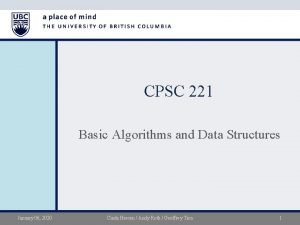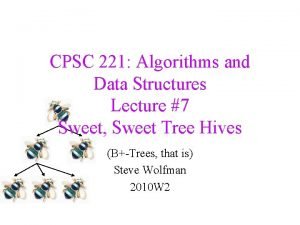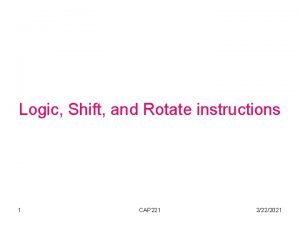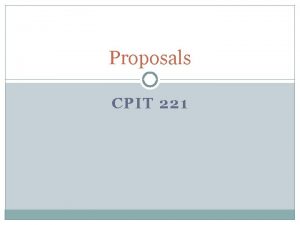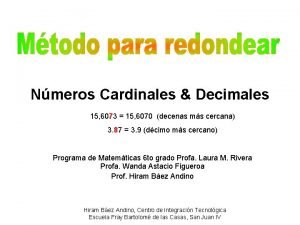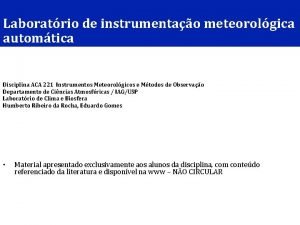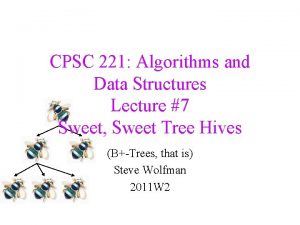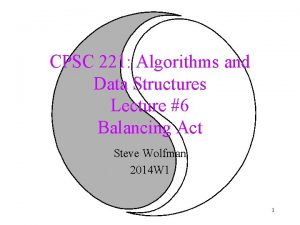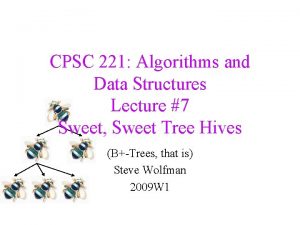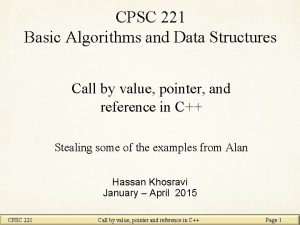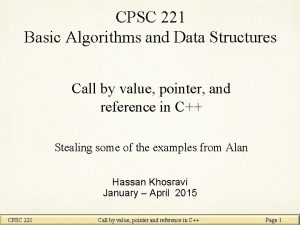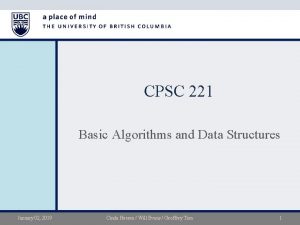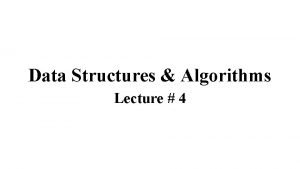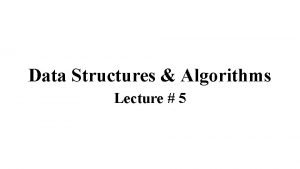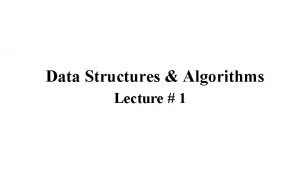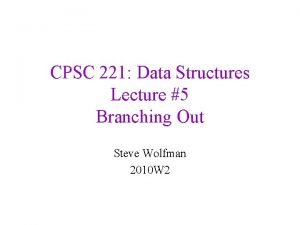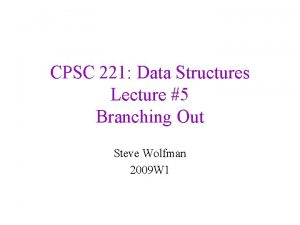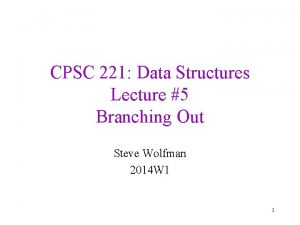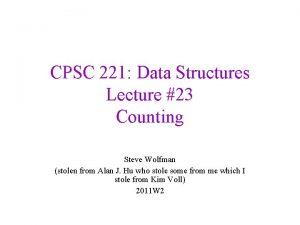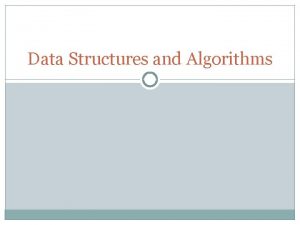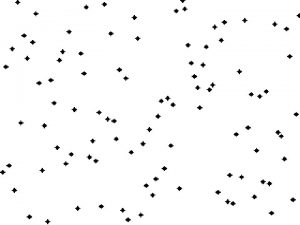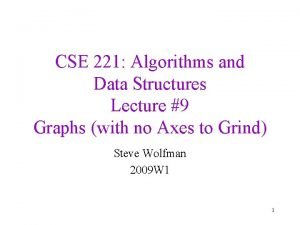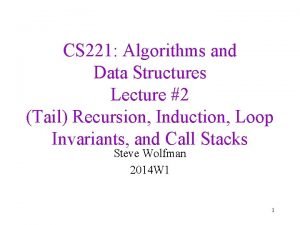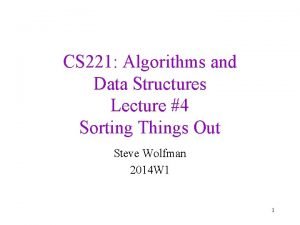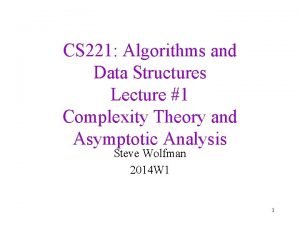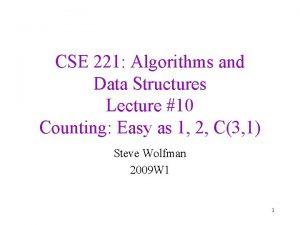CPSC 221 Algorithms and Data Structures Lecture 6































- Slides: 31

CPSC 221: Algorithms and Data Structures Lecture #6 Balancing Act Steve Wolfman 2010 W 2

Learning Goals After this unit, you should be able to: • Compare and contrast balanced/unbalanced trees. • Describe and apply the rotation algorithm to a BST to implement a balanced tree. • Recognize balanced binary search trees (among other tree types you recognize, e. g. , heaps, general binary trees, general BSTs). 2

Today’s Outline • Addressing one of our problems • Single and Double Rotations • AVL Tree Implementation

Beauty is Only (log n) Deep • Binary Search Trees are fast if they’re shallow: – perfectly complete except the one level fringe (like a heap) – anything else? What matters here? Problems occur when one branch is much longer than the other!

Balance • Balance t 5 – height(left subtree) - height(right subtree) – zero everywhere perfectly balanced – small everywhere balanced enough Balance between -1 and 1 everywhere maximum height of ~1. 44 lg n 7

AVL Tree Dictionary Data Structure • Binary search tree properties 8 – binary tree property – search tree property 5 11 • Balance property – balance of every node is: -1 b 1 – result: • depth is (log n) 2 6 4 10 7 9 13 12 14 15

Testing the Balance Property 10 5 15 2 9 7 NULLs have height -1 20 17 30

An AVL Tree 10 3 3 10 2 0 5 20 1 2 9 0 7 1 30 0 17 height children 2 0 15 data

Today’s Outline • Addressing one of our problems • Single and Double Rotations • AVL Tree Implementation

But, How Do We Stay Balanced? • Need: three volunteers proud of their very diverse height.

Beautiful Balance Insert(middle) Insert(small) Insert(tall) 1 0 0

Bad Case #1 Insert(small) Insert(middle) Insert(tall) 2 1 0

Single Rotation 2 1 1 0 0 0

General Single Rotation a h+1 h+2 b h-1 b h a h X h h-1 Y Z h-1 Z Y An insert made this BAD! • After rotation, subtree’s height same as before insert! • Height of all ancestors unchanged. So? X

Bad Case #2 Insert(small) Insert(tall) Insert(middle) 2 1 0

Double Rotation 2 2 1 1 0 0 0

General Double Rotation a h+2 h+1 b h-1 c W h - 1? c h-1 h Z a h-1 X X Y h Y W Z h - 1? • Height of subtree still the same as it was before insert! • Height of all ancestors unchanged.

Today’s Outline • Addressing one of our problems • Single and Double Rotations • AVL Tree Implementation

Insert Algorithm • • Find spot for value Hang new node Search back up for imbalance If there is an imbalance: case #1: Perform single rotation and exit case #2: Perform double rotation and exit Mirrored cases also possible

Easy Insert 3 10 Insert(3) 1 0 2 2 5 15 9 0 0 1 12 20 0 17 0 30

Hard Insert (Bad Case #1) 3 10 Insert(33) 2 2 5 15 1 2 0 9 3 0 0 1 12 20 0 17 0 30

Single Rotation 3 3 10 2 3 5 0 9 3 2 15 1 2 10 0 0 20 0 17 5 20 1 2 12 2 2 0 1 30 0 33 9 3 0 1 1 15 0 12 17 30 0 0 33

Hard Insert (Bad Case #2) 3 10 Insert(18) 2 2 5 15 1 2 0 9 3 0 0 1 12 20 0 17 0 30

Single Rotation (oops!) 3 3 10 2 3 5 0 9 3 2 15 1 2 10 0 0 20 1 2 0 17 30 0 18 5 20 1 2 12 3 0 9 3 0 2 0 15 0 12 30 17 1 0 18

Double Rotation (Step #1) 3 3 10 2 3 5 0 9 3 2 15 1 2 10 0 0 20 1 2 0 17 5 15 1 2 12 3 30 0 9 0 0 2 12 17 1 3 20 0 0 18 18 Look familiar? 0 30

Double Rotation (Step #2) 3 3 10 2 3 5 0 2 15 1 2 10 9 0 0 17 2 0 1 3 20 0 18 5 17 1 2 12 2 0 30 9 3 0 1 1 15 0 12 20 0 0 18 30

AVL Algorithm Revisited • Recursive • Iterative 1. Search downward for spot 2. Insert node 3. Unwind stack, correcting heights a. If imbalance #1, single rotate b. If imbalance #2, double rotate 1. Search downward for spot, stacking parent nodes 2. Insert node 3. Unwind stack, correcting heights a. If imbalance #1, single rotate and exit b. If imbalance #2, double rotate and exit (Parent pointers make iterative version easier. )

Single Rotation Code void Rotate. Left(Node *& root) { Node * temp = root->right; root->right = temp->left; X temp->left = root; root->height = max(height(root->right), height(root->left)) + 1; temp->height = max(height(temp->right), height(temp->left) + 1; root = temp; } root temp Y Z (The “height” function returns -1 for a NULL subtree or the “height” field of a non-NULL subtree. ) Notice that root is a reference parameter. MUST be the “correct” pointer.

Double Rotation Code void Double. Rotate. Left(Node *& root) { Rotate. Left(root->right); Rotate. Right(root); } First a a b Z c Y Rotation X W b Y X W

Double Rotation Completed Second Rotation First Rotation c a c Z b a b Y Y Z X W

Coming Up • Another approach to balancing, which leads to… • Huge Search Tree Data Structure • OR: A totally different approach to fast dictionaries: making a hash of your keys.
 Cinda heeren
Cinda heeren Cpsc 221
Cpsc 221 Csce 221 tamu syllabus
Csce 221 tamu syllabus Ajit diwan iit bombay
Ajit diwan iit bombay Cos423
Cos423 Data structures and algorithms tutorial
Data structures and algorithms tutorial Information retrieval data structures and algorithms
Information retrieval data structures and algorithms Data structures and algorithms bits pilani
Data structures and algorithms bits pilani Ajit diwan
Ajit diwan Data structures and algorithms
Data structures and algorithms Data structures and algorithms
Data structures and algorithms Ian munro waterloo
Ian munro waterloo Signature file structure in information retrieval system
Signature file structure in information retrieval system Data structures and algorithms
Data structures and algorithms Algorithms + data structures = programs
Algorithms + data structures = programs Analysis of algorithms lecture notes
Analysis of algorithms lecture notes Introduction to algorithms lecture notes
Introduction to algorithms lecture notes 01:640:244 lecture notes - lecture 15: plat, idah, farad
01:640:244 lecture notes - lecture 15: plat, idah, farad Homologous structures examples
Homologous structures examples Muthukrishnan data stream algorithms
Muthukrishnan data stream algorithms Csce 221 tamu syllabus
Csce 221 tamu syllabus Phy 221 msu
Phy 221 msu People first timesheet
People first timesheet Cap 221
Cap 221 Sp 221
Sp 221 Emmett independent school district
Emmett independent school district Epsc 221
Epsc 221 Cpit 221
Cpit 221 221 - 206
221 - 206 Cpit221
Cpit221 1 decena de millar mas 3 centesimos
1 decena de millar mas 3 centesimos Aca 221
Aca 221
